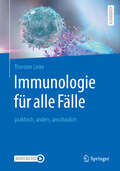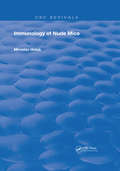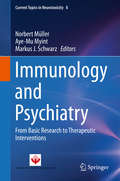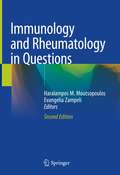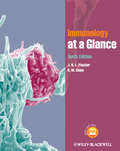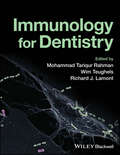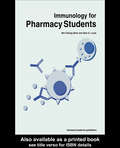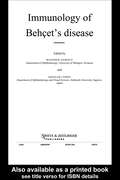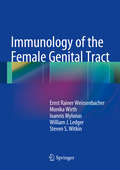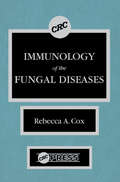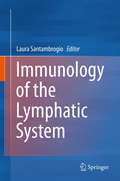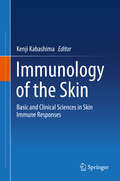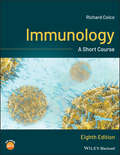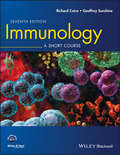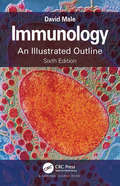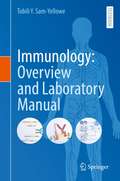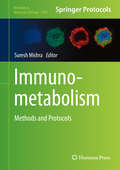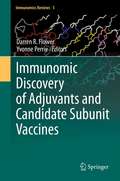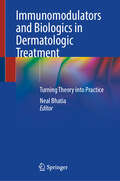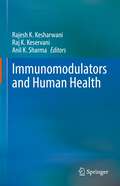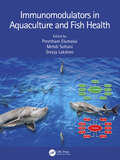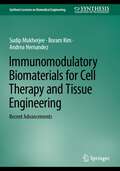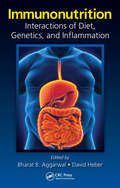- Table View
- List View
Immunologie für alle Fälle: praktisch, anders, anschaulich
by Thorsten LiekeDie bunte Truppe gegen KrankheitenWer spielt im Immunsystem eigentlich alles mit? Und was sind die jeweiligen Aufgaben? Und warum kann ich mir das alles so schlecht merken? Antworten auf diese und weitere Fragen finden Sie in diesem Buch. Der Autor führt Sie durch die Geschichte der Familie Grieger, die im Laufe des Buches mit Infektionen aller Art konfrontiert ist. Sie erfahren anschaulich, welche Strategien die Erreger anwenden und was unser Immunsystem dem entgegenzusetzen hat. Teils mit, aber auch teils ohne ausreichenden Erfolg.Lernen Sie die Immunzellen als kleine Persönlichkeiten kennen - Sie werden sie nicht mehr vergessenÜberblicken Sie die Zusammenhänge in prägnanten Übersichten - kompakt und zum NachschlagenLassen Sie sich in die Praxis mitnehmen - 11 spannende Fälle verbinden die Grundlagen mit dem SpeziellenUnd damit die Fakten für die Prüfung gut sitzen gibtes zu jedem Kapitel FlashCards.Immunologie - charmant statt schwierig!
Immunology Of Nude Mice (Routledge Revivals)
by Miroslav HolubFirst published in 1989, Immunology of Nude Mice presents a discussion of the nature of this viable laboratory mutant. This new volume updates all immunological information contained in the sparse literature concerning nude mice. It comprehensively explores some of the fre-quent questions associated with nude mice, such as if the mutant is really athymic or if the thymic defect causes all of the other deviations from brain to gonads. The practical consequences of hairlessness of the mutant are also consid-ered. Illustrated with original photographs and tables doc-umenting novel facts in immunology and physiology of nude mice, this publication is valuable for investigators and stu-dents entering the field.
Immunology and Evolution of Infectious Disease
by Steven A. FrankFrom HIV to influenza, the battle between infectious agents and the immune system is at the heart of disease. Knowledge of how and why parasites vary to escape recognition by the immune system is central to vaccine design, the control of epidemics, and our fundamental understanding of parasite ecology and evolution. As the first comprehensive synthesis of parasite variation at the molecular, population, and evolutionary levels, this book is essential reading for students and researchers throughout biology and biomedicine.The author uses an evolutionary perspective to meld the terms and findings of molecular biology, immunology, pathogen biology, and population dynamics. This multidisciplinary approach offers newcomers a readable introduction while giving specialists an invaluable guide to allied subjects. Every aspect of the immune response is presented in the functional context of parasite recognition and defense--an emphasis that gives structure to a tremendous amount of data and brings into sharp focus the great complexity of immunology. The problems that end each chapter set the challenge for future research, and the text includes extensive discussion of HIV, influenza, foot-and-mouth disease, and many other pathogens.This is the only book that treats in an integrated way all factors affecting variation in infectious disease. It is a superb teaching tool and a rich source of ideas for new and experienced researchers. For molecular biologists, immunologists, and evolutionary biologists, this book provides new insight into infectious agents, immunity, and the evolution of infectious disease.
Immunology and Psychiatry
by Norbert Müller Aye-Mu Myint Markus J. SchwarzPsychiatric disorders are one of the most dramatic burdens for humankind. The role of immune dysfunction in the pathophysiology of these disorders has emerged during the last years, because there has been tremendous progress in psychoneuroimmunological research. Many results are presented here by pioneers in the field. The book addresses various effects of the immune system on the pathophysiology and course of psychiatric disorders and highlights the possible future impact on treatment decisions of various psychiatric disorders, including schizophrenia and depression. The contributions cover the role of in utero immune challenges on the development of schizophrenia, the role of infections, and autoimmune diseases and mild immune activation in the development of depression and schizophrenia, the influence of immune responses in other disorders such as Tourette's, Alzheimer's, and OCD, the connections between mental and physical pain as well as between anti-inflammatory and antipsychotic drugs.
Immunology and Rheumatology in Questions
by Haralampos M. Moutsopoulos Evangelia ZampeliImmunology and Rheumatology in Questions, 2nd Edition addresses through short and concise questions-and-answers (Q&As) on one hand all major aspects of basic clinical and laboratory immunology necessary for understanding underlying immunological mechanisms of autoimmune rheumatic diseases. The majority however of Q&As in this book presents in a laconic way definitions, pathogenetic aspects, clinical and laboratory manifestations, differential diagnosis and the management of all categories of rheumatic diseases including systemic autoimmune, autoinflammatory, metabolic and degenerative. Furthermore, in separate sections of this manual Q&As addressing rheumatic manifestations from other organ systems are included. Finally, a chapter is devoted to treatment of rheumatic diseases analyzing indications and side-effects of different therapeutic modalities with illustrations and diagrams utilized throughout the book to present the information in a clear and schematic way. In this fully revised second edition, more than 120 new Q&As have been added and the answers to more than 90 Q&As has been modified after having critically incorporated all new knowledge generated in the past three years in the field of rheumatology, in an effort to bridge classical and current evidence-based knowledge and to present didactic and credible information. This book is valuable to test and acquire knowledge not only for rheumatologists but for every specialist in internal medicine, family practice, physical/rehabilitation medicine and orthopedic surgery.
Immunology at a Glance
by J.H.L. Playfair B. M. ChainImmunology at a Glance provides a user-friendly overview of the body's defence mechanisms. Ideal from day one of a medical, biomedical or life science course, the text begins with a basic overview of both adaptive and innate immunity, before progressing to applied immunological concepts, which look at what happens when things go wrong, and how, in clinical medicine, each body system can be affected by immunity. Each double-page spread corresponds to a typical lecture and diagrammatically summarises core concepts in immunology, through accessible schematic diagrams on left-hand pages, with key points concisely summarised on the right-hand page. There are also self-assessment essay questions so you can test your knowledge. New for this 10th edition: Thoroughly updated and reorganised chapters offer greater clarity and easier understanding for those new to the subject New chapters on cytokine receptors and 'Immunology in the Laboratory' A completely re-written section on autoimmunity A brand new companion website featuring self-assessment questions and PowerPoint slides of images from the book, ideal for teaching and revision at www. ataglanceseries. com/immunology Immunology at a Glance is the ideal companion for anyone about to start a new course in immunology and will appeal to medical and biomedical science students. Perfect for exam preparation, it provides the concepts and frameworks you need to succeed in your exam.
Immunology for Dentistry
by Richard J. Lamont Mohammad Tariqur Rahman Wim TeughelsImmunology for Dentistry Understand the fundamentals of oral immunology with this accessible reference Immunology for Dentistry fulfils the need for a comprehensive overview of oral immunology and its key aspects for dental medicine. Its broad-based and accessible coverage introduces readers to all essential elements of oral immunology, from mechanisms of the immune system through to specific diseases and pathogens and their interactions with the immune system. This thorough text will provide an understanding of the link between the oral immune system and oral microbiome as contributors to oral health. Readers will also find: A thorough introduction to the basic principles of immunology and immune response Detailed coverage of subjects including stem cell immunology, periodontitis, hormone modulation in periodontal inflammation and more Color diagrams demonstrating key concepts Authored by a team of international experts, Immunology for Dentistry provides a valuable approach to the fundamental and clinical aspects of immunology. It is a useful reference for dental students, teachers, and researchers, and will also be of interest to practicing dentists and specialists.
Immunology for Pharmacy Students
by Wei-Chiang Shen Stan G. LouieResponding to the clear need for an immunology text written with the pharmacist and pharmaceutical scientist in mind, this volume highlights issues of particular relevance to pharmacy practice, including hypersensitivity reactions to natural allergens and pharmaceutical agents. Core immunological issues, such as congenital immunodeficiency disorder
Immunology of Behçet's Disease
by Manfred Zierhut Shigeaki OhnoBeh's Disease (BD) is one of the most-studied systemic disorders characterized by an occlusive vasculopathy of multiple organs. The etiology and pathogenesis of BD are still unclear, but there is evidence for genetic, immunologic and infectious factors in the onset and throughout the course of the disease. This book summarizes our knowledge regarding the most important factors that induce or trigger BD. After an epidemiological overview, the clinical presentation of ocular and non-ocular symptoms of BD is summarized. The immunopathological changes reflect a chronic vasculitis of arterioles, venules, and capillaries. The book covers the role of T-cells, NK-T-cells, secreted cytokines, and neutrophils as well as immune reactions against various microbial heat shock proteins. It shows that the pathogenic gene involved in the development of BD is pinpointed to HLA-B51. It also discusses the treatment of BD, including anti-TNF-alpha-antibodies and interferon-alpha.
Immunology of the Female Genital Tract
by Ernst Rainer Weissenbacher Monika Wirth Ioannis Mylonas Klinik Für Geburtshilfe William J. Ledger Steven S. WitkinThis book systematically reviews and discusses recent studies and articles on the immunology of female genital tract tissue. The scope is broad, encompassing innate immune responses, adaptive (humoral and cell-mediated) immunity, the immunology of menstruation, the immunology of viral and bacterial infections, the immunology of normal and abnormal pregnancy, and immunological infertility. Throughout, tables and illustrations are judiciously used to facilitate understanding. Immunology of the Female Genital Tract will serve as an invaluable source of up-to-date information for all with an interest in this subject.
Immunology of the Fungal Diseases
by Rebecca A. CoxThis informative text is divided into eight chapters, each of which presents a comprehensive review of natural and acquired host defense mechanisms in a major mycotic disease. The chapters are written by distinguished scientists whose studies have contributed significantly to the understanding of the immunology of the mycoses. This text should provide a valuable reference for researchers, practicing clinicians, and new investigators entering this expanding field.
Immunology of the Lymphatic System
by Laura SantambrogioThis book will be a comprehensive study of the lymphatic system and its immunological role. It will begin with lymphatic capillaries, their origin and development. It will treat lymph circulation, in general, with a special emphasis on lymph circulation in parenchymal organs. The next section will address lymph nodes, subcortical circulation and the conduit system. It will discuss organs with no lymphatic system, such as the brain. Finally, it will cover lymph composition and cells in the lymph. While primarily basic research, the volume will touch upon elements of the clinical, as well, broadening its scope and appeal.
Immunology of the Skin
by Kenji KabashimaThis book reviews the role of each cell subset in the skin, providing the basics for understanding skin immunology and the mechanisms of skin diseases. The skin is one of the immune organs and is continually exposed to foreign antigens and external stimuli that must be monitored and characterized for possible elimination. Upon exposure to foreign antigens, the skin can elicit a variety of immune responses in harmony with skin components that include keratinocytes, dendritic cell subsets, mast cells, basophils, fibroblasts, macrophages, gamma-delta T cells, neutrophils, myeloid-derived suppressor cells, vascular and lymphatic cells, hair follicles, platelets, and adipose tissues, among others. In the past 10 years, knowledge of immunology has expanded drastically in areas such as innate immunity (Toll-like receptors, C-type lectins), and host defenses to bacteria and viruses, and this increased knowledge has led to the development of more effective treatment of psoriasis and other skin diseases. This book provides updates on the mechanisms of skin diseases including contact dermatitis, atopic dermatitis, psoriasis, urticaria, drug eruption, bullous diseases, anaphylaxis, graft-versus-host disease, rosacea, lymphoma, photodermatology, and collagen vascular diseases. Understanding the basics of skin immunology will help clinicians and dermatologists use new therapeutics such as biologics efficiently. Serving as an intermediary between basic science and clinical medicine, this book gives readers the opportunity to understand and marvel at the mystery and fascination of skin immunology.
Immunology: A Short Course
by Richard CoicoImmunology: A Short Course provides an overview of the physiology of the immune system and the pathophysiology of a broad range of immune-mediated diseases, offering accessible and comprehensive guidance to the basic concepts and clinical approaches in the discipline. Now in its eighth edition, this bestselling textbook has been fully updated to reflect our expanded knowledge of how the immune system develops and functions, and the ways in which these physiological phenomena can fail or be compromised. New chapters examine cells and organs of the immune system, organization and expression of lymphocyte antigen receptor genes, experimental systems and methods, and B- and T-cell development activation. Helping students gain an integrated understanding of immunology, this textbook: Offers substantial new and revised material, expanded clinical coverage, enhanced pedagogical features, and updated figures, tables, and references Features recent research advances and therapeutic successes in the field of immunology Includes a companion website containing multiple choice questions, electronic flashcards, downloadable figures, PowerPoint slides, and sample cases Can be supplemented with the Clinical Cases in Immunology companion book The eighth edition of Immunology: A Short Course is an ideal resource for life and health science students, dental and nursing students seeking a short course text, and basic scientists and clinical researchers looking to refresh their knowledge in the subject.
Immunology: A Short Course (Short Course Ser.)
by Richard Coico Geoffrey SunshineImmunology: A Short Course, Seventh Edition introduces all the critical topics of modern immunology in a clear and succinct yet comprehensive fashion. The authors offer uniquely-balanced coverage of classical and contemporary approaches and basic and clinical aspects. The strength of Immunology: A Short Course is in providing a complete review of modern immunology without the burden of excessive data or theoretical discussions. Each chapter is divided into short, self-contained units that address key topics, illustrated by uniformly drawn, full-color illustrations and photographs.This new edition of Immunology: A Short Course: * Has been fully revised and updated, with a brand new art program to help reinforce learning* Includes a new chapter on Innate Immunity to reflect the growth in knowledge in this area * Highlights important therapeutic successes resulting from targeted antibody therapies* Includes end of chapter summaries and review questions, a companion website at www.wileyimmunology.com/coico featuring interactive flashcards, USMLE-style interactive MCQs, figures as PowerPoint slides, and case-based material to help understand clinical applications
Immunology: An Illustrated Outline
by David MaleImmunology: An Illustrated Outline is both a guide to the essential principles of immunology and a concise dictionary of immunological terms. The book can be used to consolidate understanding in preparation for course exams and medical licensing exams, or as a refresher when immunology is encountered in related life sciences, such as microbiology, virology, and zoology. The book is organized into five sections that represent the major topics in basic and clinical immunology. The Sixth Edition has been comprehensively revised to highlight the latest understanding of the field, particularly in the areas of innate immune defenses and antibody-based therapeutics. Concise explanations of immunological terms Full-color illustrations and micrographs to reinforce the text Each topic is set out in single- or double-page spreads Tables collate and summarize detailed information
Immunology: Overview and Laboratory Manual
by Tobili Y. Sam-YelloweA two-in-one text providing teaching lab students with an overview of immunology as well as a lab manual complete with current standard exercises. Section I of this book provides an overview of the immune system and immunity, and includes review questions, problem sets, case studies, inquiry-based questions, and more to provide students with a strong foundation in the field. Section II consists of twenty-two lab exercises focused on key concepts in immunology, such as antibody production, cell separation, cell function, immunoassays, Th1/Th2 cytokine detection, cell and tissue culture methods, and cell and molecular biology techniques. Appendices include safety information, suggested links and readings, and standard discipline processes, protocols, and instructions.
Immunometabolism: Methods and Protocols (Methods in Molecular Biology #2184)
by Suresh MishraThis detailed book showcases the tremendous effort and progress made in developing techniques and protocols for the study of immunometabolism, and in utilizing recent technological advances for probing and manipulating adipose and immune cells, and subsequently, their functions and immunometabolic consequences. Written by experts in the field, many chapters use macrophages as a model immune cell type, due to their prominence in the innate immune system and the exhaustive study of their traits. Protocols using adipocytes, dendritic cells, and T cells as model cell lines, as well as measurement of glucose metabolism at the systemic level, have also been included. Written for the highly successful Methods in Molecular Biology book series, chapters include introductions to their respective topics, lists of the necessary materials and reagents, step-by-step, readily reproducible protocols, and tips on troubleshooting and avoiding known pitfalls. Authoritative and practical, Immunometabolism: Methods and Protocols serves as a vital guide for researchers working at the important interface of immunology and metabolism.
Immunomic Discovery of Adjuvants and Candidate Subunit Vaccines
by Yvonne Perrie Darren R. FlowerThis volume will address an important emergent area within the field of immunomics: the discovery of antigens and adjuvants within the context of reverse vaccinology. Conventional approaches to vaccine design and development requires pathogens to be cultivated in the laboratory and the immunogenic molecules within them to be identifiable. Conventional vaccinology is no longer universally successful, particularly for recalcitrant pathogens. By using genomic information we can study vaccine development in silico: 'reverse vaccinology', can identify candidate subunits vaccines by identifying antigenic proteins and by using equally rational approaches to identify novel immune response-enhancing adjuvants.
Immunomodulators and Biologics in Dermatologic Treatment: Turning Theory into Practice
by Neal BhatiaThis title provides a practically applicable guide to the use of immunomodulators and biologics to treat cutaneous diseases. Chapters cover the mechanisms, applications and safety concerns pertaining to the latest systemic therapies. Extensive guidance is provided on how to design lab monitoring schedules, manage patient follow-up visits, develop tapering plans and assess adverse outcomes. The book also reviews how to initiate off-label applications and establish methods of matching mechanisms for a range of diseases to the mechanisms of the available therapies. The latest updates in the development and utility of systemic immunomodulators, biologics and JAK Inhibitors from clinical trials and updated guidelines are also discussed. Immunomodulators and Biologics in Dermatologic Treatment comprehensively describes the use of a range of systemic therapies for immunomodulation in dermatology and how best to incorporate these into practice. It therefore represents a valuable resource for novice readers and experienced dermatologists involved in the management of these patients.
Immunomodulators and Human Health
by Anil K. Sharma Raj K. Keservani Rajesh K. KesharwaniThis book focuses on a broad range of immunomodulators, including both natural and synthetic ones. It highlights their role in human health. The book discusses nanotechnology-based immunomodulators with special emphasis on different types of formulation to boost the immune system. It highlights the role of immunomodulators against different microbes. This book describes important topics such as Classification and uses of various immunomodulators; Potential role of herbs and spices on immune system; Immune booster activity of prebiotics; Recent advances of nutraceutical and functional foods in Immune health; Antioxidants and immunomodulation; Nanotechnology and immunomodulators in cancer; Immunomodulatory role for the treatment and management of tuberculosis; Immunomodulation in autoimmune disorders; Herbal immunomodulators and COVID-19; Role of Cytokines as Immunomodulators and Immunomodulatory effects of endocrine disrupting chemicals. This book covers various aspects of product innovation, development, and launching of nutritional and pharmaceutical products with reference to immunomodulators. This book is meant for researchers and students in the field of immunology and pharmaceutical sciences.
Immunomodulators in Aquaculture and Fish Health
by Preetham Elumalai Sreeja Lakshmi Mehdi SoltaniThis reference book provides updated information about different immunomodulators for managing fish health and sustainable aquaculture. Immunomodulators are dietary additives that enhance innate defense mechanisms and increase resistance against specific pathogens and diseases. The book covers the different types of immunostimulants, their modes of action, and their efficacies. It also reviews safety concerns, ethical regulations, limitations, and outreach to farmers. It discusses the application of herbal immunomodulators, antioxidants, pre- and pro-biotics, in disease management. Features:• Reviews the pressing topic of reduction of antibiotic use in aquaculture • Discusses herbal immunomodulators, nutrients, antioxidants and pre- and pro-biotics • Covers the topic of progressive immunomodulation using nanotechnology • Discusses fish health management in the ever-growing aquaculture industry • Includes natural and synthetic immunomodulators The book is meant for researchers and industry experts in aquaculture, fisheries science, and veterinary medicine.
Immunomodulatory Biomaterials for Cell Therapy and Tissue Engineering: Recent Advancements (Synthesis Lectures on Biomedical Engineering)
by Sudip Mukherjee Boram Kim Andrea HernandezThis book presents the recent developments in immunomodulatory biomaterials for cell-based therapies in various diseases, including diabetes, cancer, cardiovascular disease, and bone regeneration. The authors first cover the fundamentals of conventional immunology and immunomodulation, before focusing on the history, advantages, and challenges of cell therapies. Biological cell therapy has gained immense attention for various diseases due to unique advantages it has over chemical drugs regarding cost, ease of production, toxicity, and therapeutic efficacy. However, these cell-based therapies need an inert delivery system that can locally deliver cells and minimally elicit foreign body response. The book discusses the foreign body response to the immunomodulatory biomaterials as well as the current and future strategies for potential mitigation of considerable immune responses toward immunomodulatory biomaterials and devices.
Immunonutrition: Interactions of Diet, Genetics, and Inflammation
by David Heber Bharat B. AggarwalThe interaction of immune function and nutrition underlies the low-grade chronic inflammation involved in the etiology of many common obesity-associated and age-related chronic disease conditions. This close interaction is the genesis of the term immunonutrition, which represents a new interdisciplinary field of nutritional and medical research. Im
Immunopathology in Toxicology and Drug Development
by George A. ParkerThis book provides a fundamental understanding of immunopathology and immunopathologic processes, with particular attention to nonclinical toxicology studies. Chapters provide organ system-based summaries of spontaneous pathology and common responses to xenobiotics. A companion volume, Immunopathology in Toxicology and Drug Development: Volume 1, Immunobiology, Investigative Techniques, and Special Studies, offers an overview of general immunobiology, cells of the immune system, signaling and effector molecules, and immunopathology assays. These informative and strategic books were created in response to the large segment of drug development that focuses on chronic diseases, many of which involve alterations to the immune system. Therapies that target these diseases commonly involve some form of immunomodulation. As a result, the two volumes of Immunopathology in Toxicology and Drug Development are critical texts for individuals involved in diverse aspects of drug development. Readers will acquire a thorough understanding of immunopathology for detection and accurate interpretation of pathologic effects of xenobiotics on the immune system.
